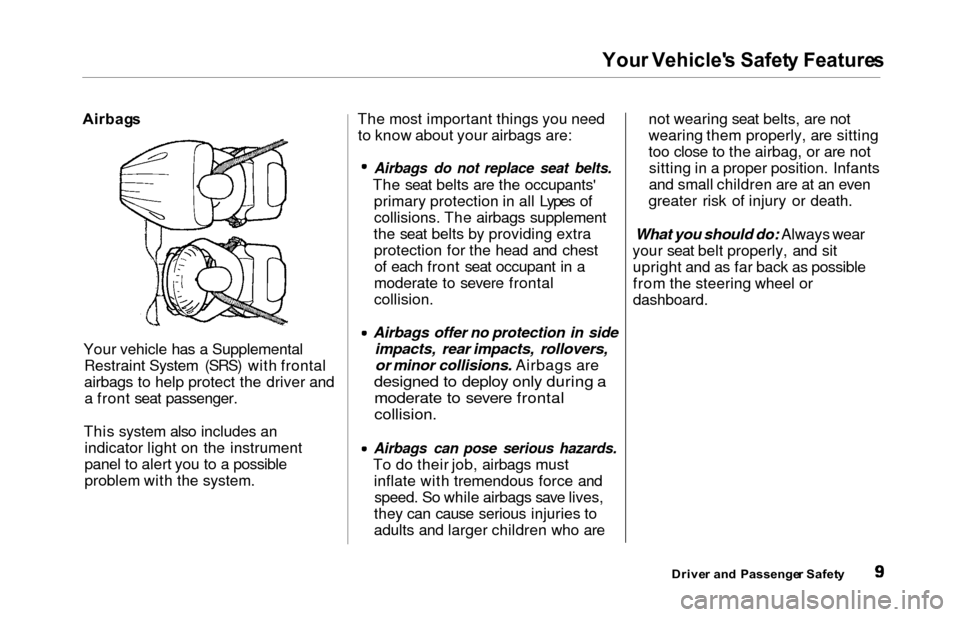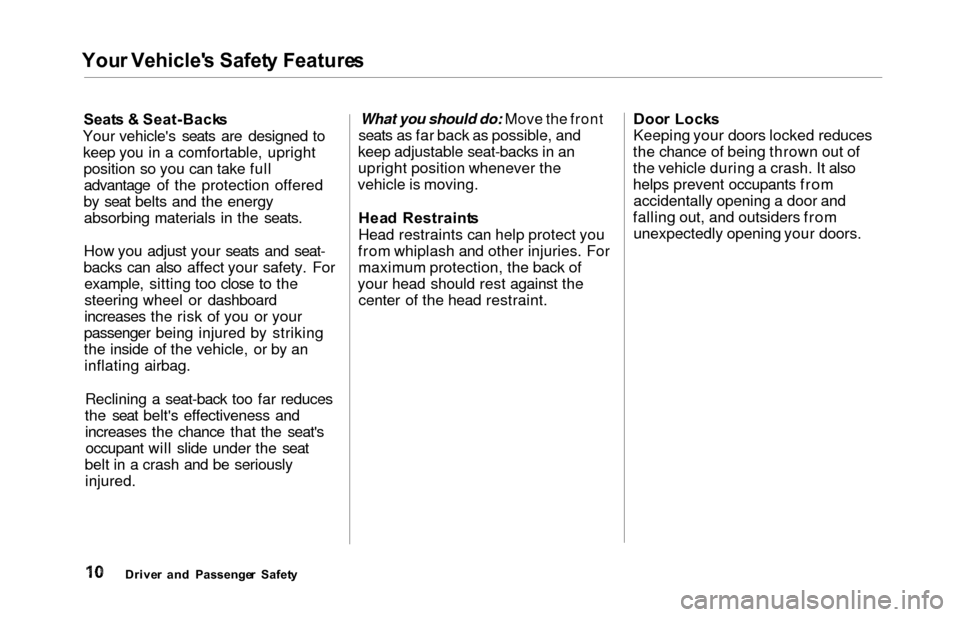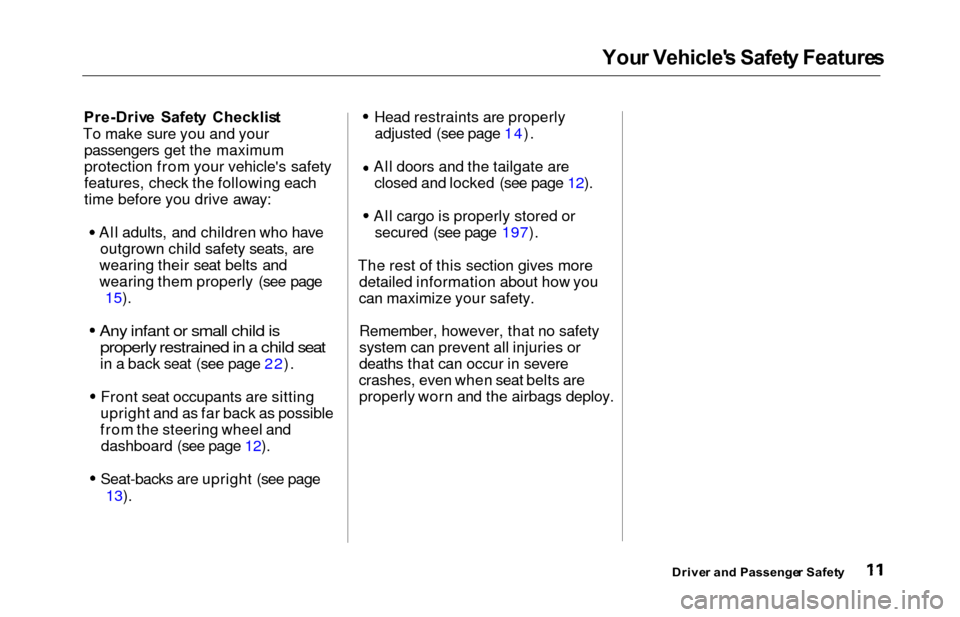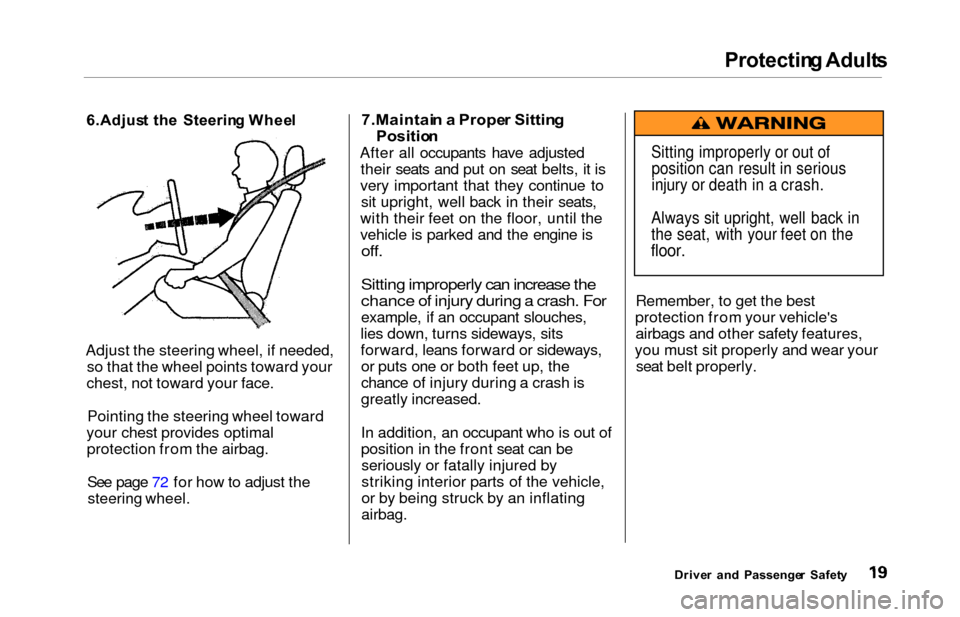2000 HONDA ODYSSEY sitting
[x] Cancel search: sittingPage 8 of 352

Driver an d Passenge r Safet y
This sectio
n gives you important
information about how to protect
yourself and your passengers. It
shows you how to use seat belts
properly. It explains your Supple-
mental Restraint System. And it tells
you how to properly restrain infants
and children in your vehicle.
Important Safety Precautions ..........
6
Your Vehicle'
s Safety Features........
7
Seat
Belts.......................................
.
8
Airbags............................................
9
Seat
s & Seat-Backs......................
10
Head
Restraints..........................
. 10
Door Locks................................... 10
Pre-Drive Safety Checklist......... 11
Protecting Adults............................. 12
1. Close and Lock the Doors...... 12
2. Adjust the Front Seats............ 12 3. Adjust the Seat-Backs............. 13
4. Adjust the Head Restraints.... 14 5. Fasten and Position the Seat
Belts...................................... 15
6. Adjust the Steering Wheel.....
19
7. Maintai
n a Proper Sitting
Position................................. 19
Advice for Pregnant Women...... 20
Additional Safety Precautions.... 20
Protecting Children......................... 22 All Children Must Be
Restrained................................ 22
Children Should Sit in the Back
Seat............................................ 23
The Passenger's Airbag Poses Serious Risks to Children....... 23
If You Must Drive with Several Children.................................... 25
If a Child Requires Close Attention................................... 25 Additional Safety Precautions.... 25
General Guidelines for Using Child Seats................................ 26
Protecting Infants........................ 30
Protecting Small Children.......... 35
Protecting Larger Children........ 39
Using Child Seats with Tethers......................................
43
Additional Informatio
n About Your
Seat Belts.................................. 45
Seat Belt System Components... 45
Lap/Shoulder Belt....................... 45
Seat Belt Maintenance................ 47
Additional Information About Your
SRS............................................
48
SRS Components........................
.
48
How
You
r Airbags Work............ 48
How the Automatic Seat Belt
Tensioners Work..................... 50
How the SRS Indicator Light
Works........................................ 50
SRS Service...................................
51
Additional Safet
y Precautions.... 52
Carbon Monoxide Hazard.............. 53
Safety Labels.................................... 54
Driver an d Passenge r Safet y
Page 10 of 352

Your Vehicle's Safety Features
(1) Safety Cage
(2) Crush Zones
(3
) Seats & Seat-Backs
(4) Head Restraints
(5)
Collapsible Steering Column
(6) Seat Belts
(7)
Airbags
(8)
Seat Belt Tensioners
(9)
Door Locks
Your vehicle is equipped with many
features that work together to protect
you and your passengers
during a crash.
Some safety features do not require
any action on your part. These
include
a strong steel framework
that
forms a safety cage around the
passenger
compartment; front and
rear crush zones that are designed to
crumple and absorb energy during a
crash;
a collapsible steering column;
and seat belt tensioners that
automatically tighten the front seat belts in the event of a crash.
These safety features are designed to reduce the severity of injuries in acrash.
However, you and your
passengers
can't take full advantage
of these safety features unless you
remain
sitting in a proper position
and always wear your seat belts
properly. I
n fact, some safety
features can contribute to injuries if they
are not used properly.
Driver and Passenger Safety
Page 12 of 352

You
r Vehicle' s Safet y Feature s
Airbag s
Your vehicle has a Supplemental Restraint System (SRS) with frontal
airbags to help protect the driver anda front seat passenger.
This system also includes an indicator light on the instrument
panel to alert you to a possible
problem with the system. The most important things you need
to know about your airbags are:Airbags do not replace seat belts.
The sea
t belts are the occupants'
primary protection in all Lypes of
collisions. The airbags supplement
the seat belts by providing extra protection for the head and chestof each front seat occupant in a
moderate to severe frontal
collision.
Airbags offer no protection in side
impacts, rear impacts, rollovers,
or minor collisions. Airbags are
designed to deploy only during a moderate to severe frontal
collision.
Airbags can pose serious hazards.
To d
o their job, airbags must
inflate with tremendous force and speed. So while airbags save lives,
they can cause serious injuries to
adults and larger children who are not wearing seat belts, are not
wearing them properly, are sitting
too close to the airbag, or are not
sitting in a proper position. Infants
and small children are at an even
greater risk of injury or death.
What you should do: Always wear
your seat belt properly, and sit upright and as far back as possible
from the steering wheel or
dashboard.
Driver an d Passenge r Safet y
Page 13 of 352

Your Vehicle' s Safet y Feature s
Seats & Seat-Back s
Your vehicle's seats are designed to keep you in a comfortable, uprightposition so you can take fulladvantage of the protection offered
by seat belts and the energy absorbing materials in the seats.
How you adjust your seats and seat-
backs can also affect your safety. For example, sitting too close to the
steering wheel or dashboard
increases the risk of you or your
passenger being injured by striking
the inside of the vehicle, or by an inflating airbag.
Reclining a seat-back too far reduces
the seat belt's effectiveness and increases the chance that the seat'soccupant will slide under the seat
belt in a crash and be seriously injured.What you should do: Move the front
seats as far back as possible, and
keep adjustable seat-backs in an
upright position whenever the
vehicle is moving.
Hea d Restraint s
Head restraints can help protect you
from whiplash and other injuries. For maximum protection, the back of
your head should rest against the center of the head restraint. Doo
r Lock s
Keeping your doors locked reduces
the chance of being thrown out of
the vehicle during a crash. It also
helps prevent occupants from accidentally opening a door and
falling out, and outsiders from unexpectedly opening your doors.
Drive r an d Passenge r Safet y
Page 14 of 352

You
r Vehicle' s Safet y Feature s
Pre-Driv e Safet y Checklis t
To make sure you and your passengers get the maximum
protection from your vehicle's safety
features, check the following each
time before you drive away: All adults, and children who have
outgrown child safety seats, are
wearing their seat belts and
wearing them properly (see page 15).
Any infant or small child is
properly restrained in a child seat
in a back seat (see page 22). Front seat occupants are sitting
upright and as far back as possible
from the steering wheel and dashboard (see page 12). Seat-backs are upright (see page
13). Head restraints are properly
adjusted (see page 14). All doors and the tailgate are
closed and locked (see page 12). All cargo is properly stored or
secured (see page 197).
The rest of this section gives more detailed information about how you
can maximize your safety.
Remember, however, that no safety
system can prevent all injuries or
deaths that can occur in severe
crashes, even when seat belts are properly worn and the airbags deploy.
Driver an d Passenge r Safet y
Page 16 of 352

Protecting Adult s
To reduce the chance of injury, wear
your seat belt properly, sit upright
with your back against the seat, andmove the seat as far back as possible
from the steering wheel while stillmaintaining full control of the
vehicle. Also make sure your front seat passenger moves the seat as far
to the rear as possible. Most shorter drivers can get far
enough away from the steering
wheel and still reach the pedals. However, if you are concerned aboutsitting too close, we recommend that
you investigate whether some type of adaptive equipment may help.
Once your seat is adjusted correctly,
rock it back and forth to make sure
the seat is locked in position.
See page 100 for how to adjust the
front seats. 3.Adjus
t th e Seat-Back s
Adjust the driver's seat-back to a comfortable, upright position,
leaving ample space between your chest and the airbag cover in the
center of the steering wheel. If you
sit too close to the steering wheel,
you could be injured if the airbag inflates.
CONTINUED
Drive r an d Passenge r Safet y
Sitting too close to an airbag
can result in serious injury or death if the airbags inflate.
Always sit as far back from the airbags as possible.
Page 22 of 352

Protecting Adult s
6.Adjus t th e Steerin g Whee l
Adjust the steering wheel, if needed, so that the wheel points toward your
chest, not toward your face.
Pointing the steering wheel toward
your chest provides optimal protection from the airbag.
See page 72 for how to adjust the
steering wheel.
7.Maintai n a Prope r Sittin g
Positio n
After all occupants have adjusted
their seats and put on seat belts, it is
very important that they continue to sit upright, well back in their seats,
with their feet on the floor, until the
vehicle is parked and the engine is
off.
Sitting improperly can increase the
chance of injury during a crash. For
example, if an occupant slouches,
lies down, turns sideways, sits
forward, leans forward or sideways, or puts one or both feet up, the
chance of injury during a crash is
greatly increased.
In addition, an occupant who is out of
position in the front seat can beseriously or fatally injured by
striking interior parts of the vehicle,
or by being struck by an inflating
airbag.
Remember, to get the best
protection from your vehicle's airbags and other safety features,
you must sit properly and wear your seat belt properly.
Drive r an d Passenge r Safet y
Sitting improperly or out of
position can result in serious
injury or death in a crash.
Always sit upright, well back in
the seat, with your feet on the
floor.
Page 45 of 352

Protecting Childre n
Physical Size
Physically, a child must be large
enough for the lap/shoulder belt to
properly fit over the hips, chest, and shoulder (see pages 15 and 39). If
the seat belt does not fit properly,
the child should not sit in the front.
Maturity
To safely ride in front, a child must be able to follow the rules, including sitting properly and wearing the seat
belt properly throughout a ride. If you decide that a child can safely
ride up front, be sure to:
Carefully read the owner's manual
and make sure you understand all
seat belt instructions and all safety
information.
Move the vehicle seat to the rear-
most position.
Have the child sit up straight, back
against the seat, and feet on or
near the floor.
Check that the child's seat belt is
properly positioned and secured.
Supervise the child. Even mature
children sometimes need to be
reminded to fasten the seat beltsor sit properly.
Drive r an d Passenge r Safet y